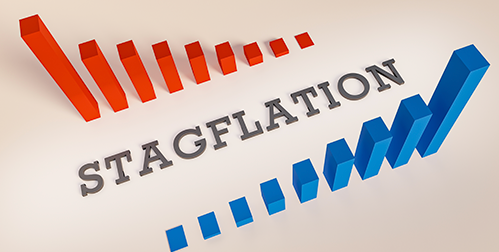Causes of Stagflation
Economists are saying the conditions are ripe for an unwelcome blast from the past. Not seen since the 1970s, stagflation is now becoming a very real possibility. The stagflation of the 70s was brought on by a perfect storm of bad policy decisions. Those decisions created rising inflation and an oil crisis that impacted economic growth. Today, bad policy decisions are also pointing us down the same path.
Plenty of economists once doubted stagflation was even possible. Unemployment and inflation typically move in opposite directions. That’s because price levels are usually driven by an economy’s level of demand.
With inflation over 8%, the Fed is adopting an aggressive interest-rate policy. This policy could force the economy into a recession. At the same time, global supply chain disruptions are driving inflation higher. Prices can continue to rise as the economy shrinks. Ultimately, creating a period of stagflation.
A Former Fed Chair Comments
Former Federal Reserve Chairman Ben Bernanke said the current Fed leaders were too slow to react to surging U.S. inflation. As a result, the U.S. faces a period of stagnant growth and high inflation.
“The forward guidance…slowed the response of the Fed to the inflation problem,” Bernanke said. “I think, in retrospect, it was a mistake and I think they agree it was a mistake.”1
Forward guidance refers to the communication from a central bank about the state of the economy. It explains the likely future course of monetary policy.
Bernanke said current Reserve Chairman Powell chose to respond gradually to surging inflation. He didn’t want to shock the markets. At the same time, Bernanke warned the outcome of such a slow response was going to be a poor economic performance.
When inflation hit a 40 year high, the Fed was compelled to take a more aggressive tact. They increased rates by a half point earlier this month. That is the largest single hike since 2000. Powell said similar moves were on the table for the next two meetings.
Effects of Stagflation and How to Respond to Them
Stagflation casts a dark cloud over the markets. It has historically been associated with declining profit margins. Companies face higher prices and dwindling sales. Stocks during stagflation do worse than in periods with only weak growth or high inflation.
Global financial assets have already seen months of losses. Everything from U.S. stocks to global bonds are getting dumped as central banks struggle to contain record inflation.
During times of stagflation, there is increased financial risk on an individual level. The possibility of a loss in income increases with rising unemployment. And for the households that manage to keep their jobs, their purchasing power is eroded by the sudden increase of prices for everyday necessities.
Although the future is uncertain, there are precautions you can take. For example, it’s not wise to panic and sell off your investments. Instead, take this time to refocus on saving and diversification.
Data shows that gold is one of the best ways to diversify. Year-to-date, gold has performed well. Of the four business cycle phases since 1973, stagflation is the one that is most supportive for gold. Conversely, it is the worst for risk assets.2
According to the numbers, the U.S. hasn’t hit stagflation yet. However, all the elements are in place for it to emerge. The Fed’s rate increases may push the economy into recession. However, they may not be enough to counter the inflationary forces of the Ukraine war, the renewed COVID-19 lockdowns in China, disrupted supply chains and rising energy prices. The growing risk of stagflation is leaving investors with few safe havens. The one haven that is still standing is gold. If you are looking to protect your assets, then you should contact American Hartford Gold about the benefits of a Gold IRA.






